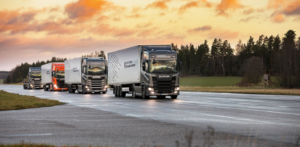In the modern world, fossil fuel combustion is the biggest contributor to air pollution. Factories and power plants contribute to some extent, but the biggest culprit today is traffic. While cars far outnumber trucks on the road, the freight industry is regrettably a major source of this pollution. Let’s face it….
When it Comes To Air Pollution, Trucks are Dirty
Statistics from the Environmental Protection Agency (EPA) show that medium- and heavy-duty truck freight account for 7 percent of all U.S. greenhouse gas emissions, or 436.5 million metric tons of CO2 equivalent in 2017. Surprisingly, about 76 million metric tons (6%) of this amount happens when trucks are traveling deadhead miles (running empty).
https://convoy.com/blog/quantifying-a-greener-future-for-freight/
Deadheading has always been a seemingly unavoidable part of the freight business. It occurs when a trucker drops off a load but has to drive elsewhere (with an empty trailer) to pick up another load. Deadhead miles have consistently represented about one-third of all miles driven by heavy trucks for the last twenty years.
In the nearly twenty years we’ve been in business, DriverSource has seen many advances in trucking. New technologies are taking place focused on eliminating deadhead miles while bringing improved efficiencies to the industry. This is all leading us down a greener path to environmental sustainability…and that’s a good thing!
On-Demand Trucking – Reducing Deadhead Miles To Make Trucking Greener
Reducing the number of deadhead miles is a key to trucking moving towards a more environmentally sustainable path. Technology has introduced a number of on-demand digital freight matching platforms for carriers and owner-operator truckers to find work, reduce empty miles, and put money in their pockets quicker. Applications accessible via smartphones enable drivers to make real-time bidding on loads based on their schedule and preferred rates, guaranteeing that they spend less time looking for work or driving empty (deadhead).
Uber and Amazon are both developing apps for the digital freight matching space. Other key players include Fourkites, Cargomatic, and Convoy.
https://www.logisticsmgmt.com/article/digital_freight_matching_the_race_is_on
Improving Truck’s Fuel Economy Can Also Make Trucking Greener
Advances are taking place in improving the fuel economy of trucks. While the improved mpg rates since the early 1980s for cars is much higher, heavy-duty trucks saw an increase in efficiency of about 20 percent. But, anyone in the freight business knows that changes are coming that could radically improve heavy-duty truck fuel economy. https://www.eia.gov/totalenergy/data/annual/showtext.php?t=pTB0208
Alternative sources of energy are on- the-horizon to power trucks. Major players, such as Daimler, are moving forward with electric truck prototypes that hold enormous promise and can make trucking drastically greener. Platooning, which involves the linking of two or more trucks in convoy, using connectivity technology and automated driving support systems, is also expected to become common and will help to make trucking greener.
In the end, freight matching platforms combined with alternative sources of energy will substantially clean up “dirty” trucking. And, that’s good for the industry as well as the environment.
https://www.daimler.com/products/trucks/freightliner/e-mobility-group.html
Bill D for DriverSource


